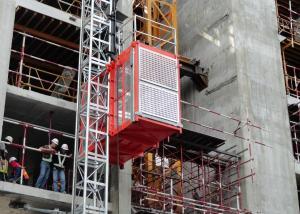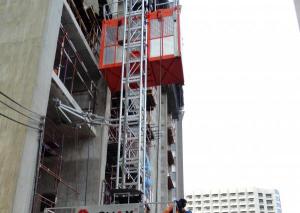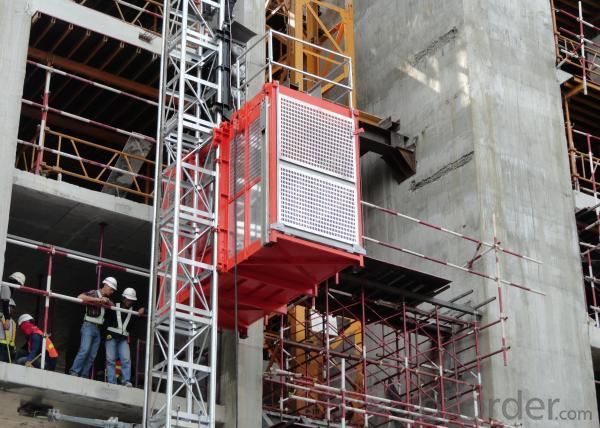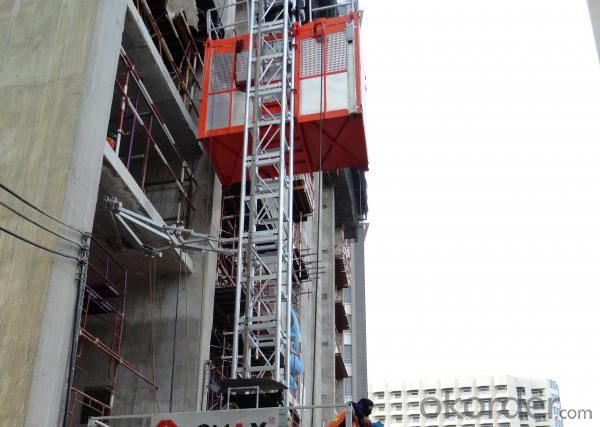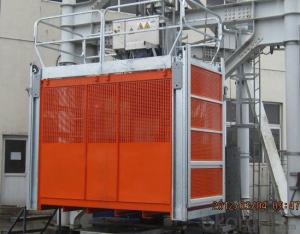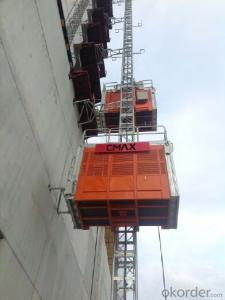Building Hoist SC100
- Loading Port:
- China Main Port
- Payment Terms:
- TT or L/C
- Min Order Qty:
- 1 Set set
- Supply Capability:
- 90 Sets Per Month set/month
OKorder Service Pledge
OKorder Financial Service
You Might Also Like
Building Hoist SC100 Technical Data
|
Lifting capacity |
1000kg |
|
Lifting speed |
33 m/min, 38m/min, 0-60m/min (VVVF+PLC), 0-90m/min (VVVF+PLC) |
|
Max. lifting height |
300m |
|
Motor type |
Chinese motor or SEW motor |
|
Anti-drop safety device |
With our patent |
|
Cage size (L x W x H) |
Recommended size: 2.5x1.2x2.4m. We can also manufacture the cages of other sizes according to the clients. |
|
Mast section |
450x450x1508mm, hot dip galvanized or paint-sprayed. |
|
Anchor |
Distance 6-9m, hot dip galvanized or paint-sprayed. |
|
★Thewhole machinecan be designed according to your specific requirements | |
Details of Hoist SC100 Technical Data
SC100 building hoist manufactured by our company have the features as good quality, long life, wide application range and convenient for maintenance. The gearing adopts imported bearing, enameled cable, and oil seal.
The electric parts adopt products from world renowned manufactures such as Schneider, Siemens, and LG.
The racks amd pinion adopts special material and heat-treatment technique, which prolong the life of these parts.
The steel structure uses quality steel from famous domestic manufacturers. The surface of the structure can apply paint-spray, parkerizng baking finish or hot galvanizing processing according to users requirements.
We can also manufacture cages of other size according to the user
The cage and the door material can be aluminum molded board, punched-plate,figured aluminum board or other type according to your requirementes
The mas and the tie-in surface can adopt paint-spray, or hot galvanizing processing.
We has passed ISO9000 quality system authentication. We have powerful R&D centre and professional customer support team. Excellent quality and service are what we actually supply with.
Packaging & Delivery
Package: nude and wooden boxes in containers.
Period of shipment: 30 days after receipt of the buyer's advance payment.
.
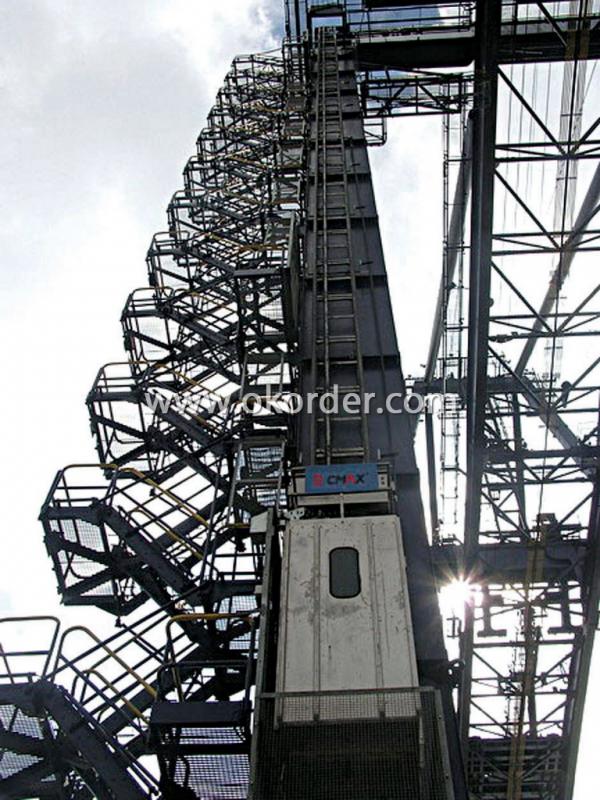

- Q: This question asks whether a building hoist can develop operational issues due to incorrect usage or lack of maintenance.
- <p>Yes, a building hoist can malfunction due to improper use or inadequate maintenance. Improper use may include overloading the hoist, using it in unsuitable conditions, or operating it without proper training. Inadequate maintenance can lead to wear and tear, lubrication issues, and component failures. Regular inspections, proper usage guidelines, and timely repairs are crucial to prevent malfunctions and ensure the safety of the hoist and its operators.</p>
- Q: Is it possible to substitute an automatic lifting device with a manual one in construction projects?
- <p>While it is technically possible to use a manual lifting device in place of an automatic one for certain construction tasks, it is not generally recommended. Manual lifting devices are typically less efficient, slower, and can pose safety risks due to the physical effort required. They may also not meet the load-bearing requirements of heavy construction materials. Automatic lifting devices are designed for efficiency, safety, and to handle heavy loads, making them more suitable for construction work. It's crucial to adhere to safety standards and use appropriate equipment for the task at hand.</p>
- Q: Excuse me: what is the meaning of heavy weight in the construction elevator?
- With double cage for heavy, namely SCD200/200 series Is the two cages, each cage has a corresponding weight, the weight up and down in the elevator cage rise to energy conservation and reduce the reaction between the up and down, when you imagine front-rear door principle is about the same
- Q: This question inquires whether a building hoist can be utilized in both indoor and outdoor environments, particularly in areas with limited space.
- <p>Yes, building hoists can be used both indoors and outdoors, but their suitability depends on the specific model and design. Some hoists are specifically engineered for indoor use due to their compact size and lower weight capacity, while others are designed for outdoor use and can handle heavier loads. In limited spaces, it's crucial to select a hoist with a small footprint and high lifting capacity relative to its size. Always ensure that the hoist meets the required safety standards and is operated by trained personnel to prevent accidents in confined spaces.</p>
- Q: This question asks about the typical issues encountered when constructing a building hoist and the methods to address these problems.
- <p>Common problems in building hoists include mechanical failure, safety hazards, and improper installation. Solutions involve regular maintenance to prevent mechanical issues, strict adherence to safety protocols to mitigate hazards, and professional installation to ensure the hoist is correctly set up. Additionally, using modern technology for monitoring and control can help to identify and rectify problems early. Ensuring proper training for operators is also crucial for the safe and efficient operation of building hoists.</p>
- Q: This question asks for the different categories of hoists used in construction.
- <p>Building hoists are essential for the construction industry and come in various types. The main types include: 1. Material Hoists, which are used for lifting building materials; 2. Personnel Hoists, designed for transporting workers; 3. Goods and Passenger Hoists, which can carry both materials and people; 4. Temporary Hoists, used during the construction phase; and 5. Permanent Hoists, installed in buildings for long-term use. Each type has specific features and safety considerations tailored to their intended use.</p>
- Q: Do the elevator need to be installed when the main project is in construction
- The top brass usually need to install the construction elevator.
- Q: There are differences between the construction elevator and the construction elevator
- When it comes to the construction elevator, people will immediately think of construction lifter, the construction elevator and elevator is just a different name or have their own respective working principle? By below small make up to you to introduce: construction elevator is often referred to as construction lifter, but construction lifter, including the definition of a broader platform construction also belongs to the construction lifter series.
- Q: What is the need for the sc200/200 construction elevator cable?
- The company now USES 3X25 + 2x10 cables
- Q: This question asks whether a building hoist can be utilized both indoors and outdoors and seeks an explanation for its suitability in both environments.
- <p>A building hoist can be used both indoors and outdoors, depending on the specific design and construction. Outdoor hoists are typically built to withstand weather conditions and are more robust, while indoor hoists are designed for controlled environments. The choice between indoor and outdoor use is determined by factors such as the building's structure, the materials being lifted, and the environmental conditions. Outdoor hoists may require additional features like weatherproofing and corrosion resistance, whereas indoor hoists focus on efficiency and ease of use within a protected setting.</p>
Send your message to us
Building Hoist SC100
- Loading Port:
- China Main Port
- Payment Terms:
- TT or L/C
- Min Order Qty:
- 1 Set set
- Supply Capability:
- 90 Sets Per Month set/month
OKorder Service Pledge
OKorder Financial Service
Similar products
Hot products
Hot Searches
Related keywords
